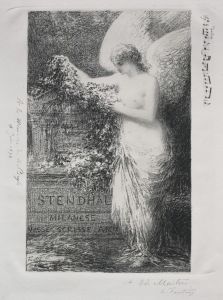
Sara la baigneuse
A hand-painted replica of Henri Fantin-Latour’s masterpiece Sara la baigneuse, meticulously crafted by professional artists to capture the true essence of the original. Each piece is created with museum-quality canvas and rare mineral pigments, carefully painted by experienced artists with delicate brushstrokes and rich, layered colors to perfectly recreate the texture of the original artwork. Unlike machine-printed reproductions, this hand-painted version brings the painting to life, infused with the artist’s emotions and skill in every stroke. Whether for personal collection or home decoration, it instantly elevates the artistic atmosphere of any space.
Henri Fantin-Latour was a French painter known for his still lifes and group portraits of Parisian artists and writers. One of his notable works is "Sara la baigneuse," which translates to "Sara the Bather." This painting exemplifies Fantin-Latour's skill in capturing the human form and his interest in classical themes.
"Sara la baigneuse" was created in the late 19th century, a period when Fantin-Latour was exploring various subjects beyond his well-known floral compositions and portraits. The painting depicts a nude female figure, a common subject in art history, which allowed artists to explore themes of beauty, form, and the human condition. Fantin-Latour's approach to the nude was influenced by his admiration for the Old Masters, and he often sought to imbue his works with a sense of timelessness and classical beauty.
The composition of "Sara la baigneuse" is notable for its simplicity and focus on the figure. Fantin-Latour employed a soft, muted palette, which is characteristic of his style, to create a serene and contemplative atmosphere. The use of light and shadow in the painting highlights the contours of the body, demonstrating Fantin-Latour's keen understanding of anatomy and his ability to render the human form with sensitivity and precision.
Fantin-Latour's technique in "Sara la baigneuse" reflects his academic training and his commitment to realism. He was known for his meticulous attention to detail and his ability to capture the subtleties of light and texture. This painting, like many of his works, reveals his dedication to traditional painting methods and his resistance to the avant-garde movements that were emerging during his lifetime.
The model for "Sara la baigneuse" is not definitively identified, which is not uncommon for works of this nature from the period. Fantin-Latour often worked with professional models, and his focus was more on the artistic representation of the figure rather than the identity of the individual. This approach allowed him to concentrate on the aesthetic and compositional elements of the painting.
"Sara la baigneuse" is part of Fantin-Latour's broader body of work that includes portraits, still lifes, and mythological scenes. While he is perhaps best known for his floral paintings, which were highly sought after during his lifetime, his figure paintings like "Sara la baigneuse" demonstrate his versatility and his ability to engage with different artistic genres.
Henri Fantin-Latour's contributions to art were recognized during his lifetime, and he was well-regarded by his contemporaries. His works continue to be appreciated for their technical skill and their ability to convey a sense of quiet beauty. "Sara la baigneuse" remains an example of his mastery of the human form and his dedication to the traditions of classical painting.


















